Russia says leak on Soyuz spacecraft caused by 0.8-millimetre hole
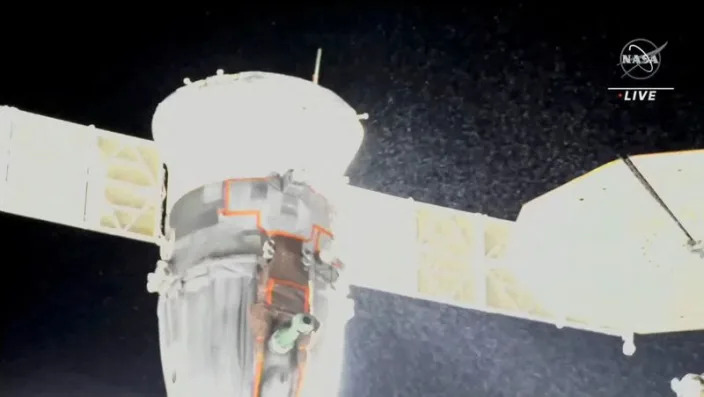
A stream of particles, which NASA says appears to be liquid and possibly coolant, sprays out of the Soyuz spacecraft on the International Space Station
Mon, December 19, 2022
MOSCOW (Reuters) - A hole less than one millimetre in diameter is to blame for a coolant leak from a Russian Soyuz spacecraft docked at the International Space Station (ISS), the head of Russia's Roscosmos space agency said on Monday.
A routine spacewalk by two Russian cosmonauts was cancelled last week after NASA noticed a stream of fluid spewing from the vessel. Temperatures on board the capsule have since risen and Roscosmos has scrambled to investigate the cause and decide how to resolve the issue.
"A preliminary check has shown that there is a small hole, around 0.8 millimetres, which caused the depressurisation," Yuri Borisov, the head of Roscosmos, told Russian state TV on Monday.
The crew were not in danger, Borisov said, and were currently based inside the ISS.
Roscosmos had planned to inspect the capsule with a 17-metre long robotic arm, named the Canadarm2, which performs maintenance, moves supplies and grapples vehicles to the ISS.
Temperatures aboard the Soyuz MS-22 capsule had now stabilised below 30 degrees Celsius (86 degrees Fahrenheit) and the capsule was in working condition, Borisov said. However, he called the situation "clearly not very good" and said that a commission would decide before the end of the month what steps should be taken next.
Roscosmos has advanced plans to potentially deploy a reserve spacecraft to ferry the cosmonauts back to Earth should the docked Soyuz MS-22 prove out of action. Borisov said the reserve spacecraft would be ready to launch by Feb. 19.
Russia has announced plans to walk away from the ISS - one of the few areas of large-scale cooperation between the United States and Russia - and launch its own space station. Borisov, who took over as the head of Roscosmos in July, has said the ISS has outlived its purpose and is "dangerous".
(Reporting by Reuters; Writing by Jake Cordell; Editing by Nick Macfie)
Russia may expedite launch of next space capsule after leak
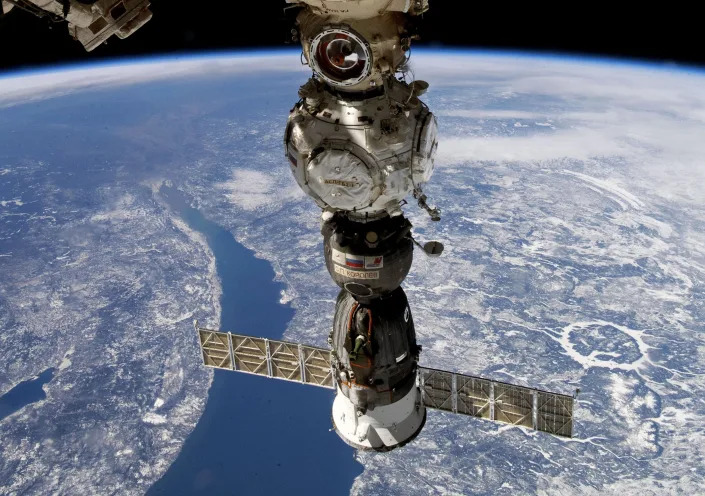
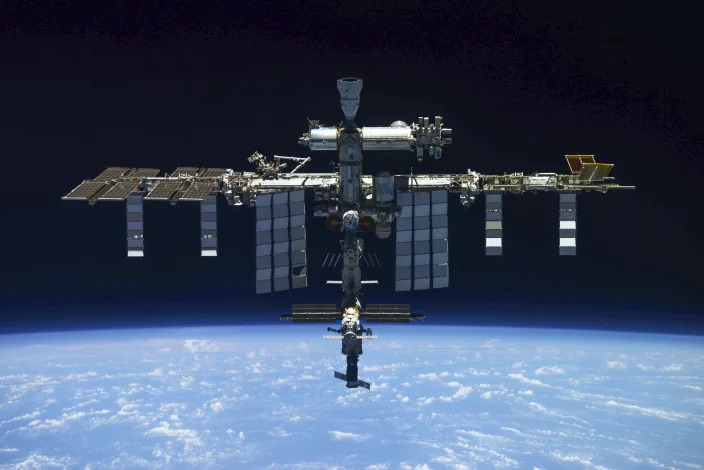
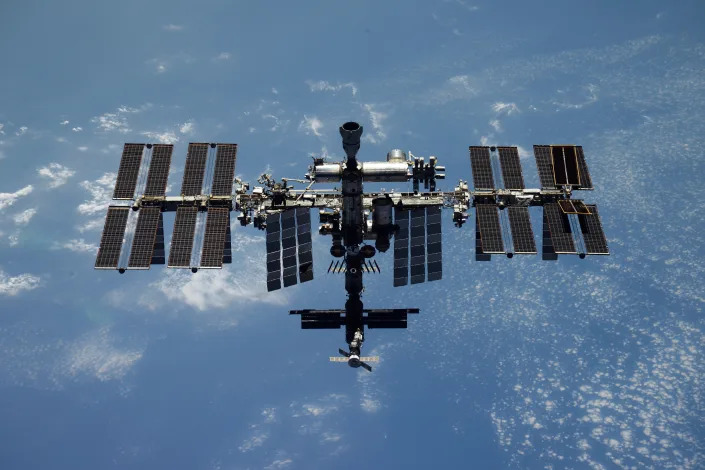
This undated handout photo released by Roscosmos State Space Corporation shows the International Space Station (ISS) during its fly. Russia's space corporation Roscosmos said Monday Dec. 19, 2022 that a coolant leak from a Russian space capsule attached to the International Space Station doesn't require evacuation of its crew, but held the door open for launching a replacement capsule if needed.

A stream of particles, which NASA says appears to be liquid and possibly coolant, sprays out of the Soyuz spacecraft on the International Space Station
Mon, December 19, 2022
MOSCOW (Reuters) - A hole less than one millimetre in diameter is to blame for a coolant leak from a Russian Soyuz spacecraft docked at the International Space Station (ISS), the head of Russia's Roscosmos space agency said on Monday.
A routine spacewalk by two Russian cosmonauts was cancelled last week after NASA noticed a stream of fluid spewing from the vessel. Temperatures on board the capsule have since risen and Roscosmos has scrambled to investigate the cause and decide how to resolve the issue.
"A preliminary check has shown that there is a small hole, around 0.8 millimetres, which caused the depressurisation," Yuri Borisov, the head of Roscosmos, told Russian state TV on Monday.
The crew were not in danger, Borisov said, and were currently based inside the ISS.
Roscosmos had planned to inspect the capsule with a 17-metre long robotic arm, named the Canadarm2, which performs maintenance, moves supplies and grapples vehicles to the ISS.
Temperatures aboard the Soyuz MS-22 capsule had now stabilised below 30 degrees Celsius (86 degrees Fahrenheit) and the capsule was in working condition, Borisov said. However, he called the situation "clearly not very good" and said that a commission would decide before the end of the month what steps should be taken next.
Roscosmos has advanced plans to potentially deploy a reserve spacecraft to ferry the cosmonauts back to Earth should the docked Soyuz MS-22 prove out of action. Borisov said the reserve spacecraft would be ready to launch by Feb. 19.
Russia has announced plans to walk away from the ISS - one of the few areas of large-scale cooperation between the United States and Russia - and launch its own space station. Borisov, who took over as the head of Roscosmos in July, has said the ISS has outlived its purpose and is "dangerous".
(Reporting by Reuters; Writing by Jake Cordell; Editing by Nick Macfie)
Russia may expedite launch of next space capsule after leak



This undated handout photo released by Roscosmos State Space Corporation shows the International Space Station (ISS) during its fly. Russia's space corporation Roscosmos said Monday Dec. 19, 2022 that a coolant leak from a Russian space capsule attached to the International Space Station doesn't require evacuation of its crew, but held the door open for launching a replacement capsule if needed.
Roscosmos State Space Corporation via AP, File
Mon, December 19, 2022
MOSCOW (AP) — Russia's space corporation Roscosmos said Monday that a coolant leak from a Russian space capsule attached to the International Space Station doesn't require evacuation of its crew, but the agency kept open the possibility of launching a replacement capsule, if needed.
Roscosmos said a panel of experts would determine later this month whether the Soyuz MS-22 capsule could be safely used by the crew for its planned return to Earth or if it should be discarded and replaced.
It said the next scheduled launch of a Soyuz was in March but could be expedited, if necessary.
The leak from the Soyuz MS-22 was spotted last week as a pair of Russian cosmonauts were about to venture outside the station on a planned spacewalk. Russian Mission Control aborted the spacewalk when ground specialists saw a stream of fluid and particles emanating from the Soyuz on a live video feed from space.
Roscosmos and NASA both have said the incident hasn’t posed any danger to the station’s crew.
Roscosmos said the leak might have been caused by a micrometeorite or a piece of space junk striking one of the capsule's external radiators.
The corporation said Monday that the leak caused the temperature in the crew section of the capsule to rise to 30 degrees Celsius (86 degrees Fahrenheit). The temperature in the equipment section initially soared to 40 degrees Celsius (104 degrees Fahrenheit) but dropped to 30 degrees Celsius (86 degrees Fahrenheit) after ground experts switched some of the capsule's systems, Roscosmos said.
Roscosmos said the crew used ventilators in the Russian segment to blow cold air into the capsule to reduce temperature in the cockpit to comfortable levels.
“The increase in temperature on the Soyuz MS-22 spacecraft is admissible and isn't critical for the functioning of the equipment or health of the crew in case they need to be in the spacecraft,” Roscosmos said, adding that tests of the ship's control system determined it wasn't affected by the incident.
The space corporation said an inspection of the capsule's surface with a camera on a Canadian-built robotic arm helped spot the location of the coolant leak.
Prokopyev, Petelin and NASA astronaut Frank Rubio used the Soyuz MS-22 to arrive at the International Space Station in September, and it has served as a lifeboat for the crew. The capsule was scheduled to carry some of the space station’s crew back to Earth in March as part of regular rotations.
Along with Prokopyev, Petelin and Rubio, four other crew members are currently on the space outpost: NASA astronauts Nicole Mann and Josh Cassada; the Japan Aerospace Exploration Agency’s Koichi Wakata; and Anna Kikina of Roscosmos.
Leak Inspection Finds Hole in Russian Spacecraft Docked to ISS
George Dvorsky
Mon, December 19, 2022
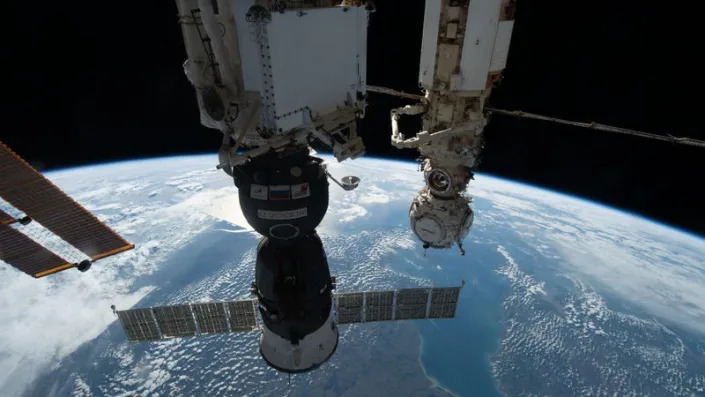
The Soyuz MS-22 spacecraft docked to the Russian Rassvet
MOSCOW (AP) — Russia's space corporation Roscosmos said Monday that a coolant leak from a Russian space capsule attached to the International Space Station doesn't require evacuation of its crew, but the agency kept open the possibility of launching a replacement capsule, if needed.
Roscosmos said a panel of experts would determine later this month whether the Soyuz MS-22 capsule could be safely used by the crew for its planned return to Earth or if it should be discarded and replaced.
It said the next scheduled launch of a Soyuz was in March but could be expedited, if necessary.
The leak from the Soyuz MS-22 was spotted last week as a pair of Russian cosmonauts were about to venture outside the station on a planned spacewalk. Russian Mission Control aborted the spacewalk when ground specialists saw a stream of fluid and particles emanating from the Soyuz on a live video feed from space.
Roscosmos and NASA both have said the incident hasn’t posed any danger to the station’s crew.
Roscosmos said the leak might have been caused by a micrometeorite or a piece of space junk striking one of the capsule's external radiators.
The corporation said Monday that the leak caused the temperature in the crew section of the capsule to rise to 30 degrees Celsius (86 degrees Fahrenheit). The temperature in the equipment section initially soared to 40 degrees Celsius (104 degrees Fahrenheit) but dropped to 30 degrees Celsius (86 degrees Fahrenheit) after ground experts switched some of the capsule's systems, Roscosmos said.
Roscosmos said the crew used ventilators in the Russian segment to blow cold air into the capsule to reduce temperature in the cockpit to comfortable levels.
“The increase in temperature on the Soyuz MS-22 spacecraft is admissible and isn't critical for the functioning of the equipment or health of the crew in case they need to be in the spacecraft,” Roscosmos said, adding that tests of the ship's control system determined it wasn't affected by the incident.
The space corporation said an inspection of the capsule's surface with a camera on a Canadian-built robotic arm helped spot the location of the coolant leak.
Prokopyev, Petelin and NASA astronaut Frank Rubio used the Soyuz MS-22 to arrive at the International Space Station in September, and it has served as a lifeboat for the crew. The capsule was scheduled to carry some of the space station’s crew back to Earth in March as part of regular rotations.
Along with Prokopyev, Petelin and Rubio, four other crew members are currently on the space outpost: NASA astronauts Nicole Mann and Josh Cassada; the Japan Aerospace Exploration Agency’s Koichi Wakata; and Anna Kikina of Roscosmos.
Leak Inspection Finds Hole in Russian Spacecraft Docked to ISS
George Dvorsky
Mon, December 19, 2022

The Soyuz MS-22 spacecraft docked to the Russian Rassvet
ISS module, in a photo taken on October 8, 2022.
An inspection has revealed an 0.8-millimeter-wide hole in the Soyuz MS-22 spacecraft that sprung a coolant leak outside the International Space Station last week. Russian space agency Roscosmos will make a decision on the flight-worthiness of the spacecraft later this month, at which time Russia may choose to expedite the launch of a replacement capsule.
The hole is located on the ship’s instrumentation compartment on the Soyuz service module, according to Roscosmos chief Yury Borisov and as reported by state-run TASS news agency. “The primary guidance, navigation, control and computer systems of the Soyuz are in the instrumentation compartment, which is a sealed container filled with circulating nitrogen gas to cool the avionics equipment,” NASA says.
The Soyuz MS-22 sprung a leak on December 15, sending streams of coolant into space and canceling a Russian spacewalk. NASA and Roscosmos have both stated that the incident poses no risk to the crew or the orbiting space station. A preliminary inspection with a robotic arm confirmed the leak shortly after it began on Thursday, with a follow-up inspection, performed earlier today, now confirming the hole, which may have been caused by a micrometeorite or a tiny piece of space junk.
Today’s inspection “revealed that there is a tiny hole” in the instrumentation compartment “measuring about 0.8mm, which caused the leak,” Borisov said Monday, describing the ongoing situation as “not very pleasant.” The Russian space agency has set a deadline of December 27 to determine the status and fate of the damaged Soyuz spacecraft. Two working groups will decide whether the spacecraft can host passengers and return to the surface or if it needs to be junked.
The MS-22 capsule is slated to return NASA astronaut Frank Rubio and Roscosmos cosmonauts Sergey Prokopyev and Dmitri Petelin to Earth in early spring, but the trio may have lost their ride. A SpaceX Crew Dragon is also parked outside the ISS, but that’s reserved for NASA astronauts Nicole Mann and Josh Cassada, Koichi Wakata of the Japan Aerospace Exploration Agency (JAXA), and Anna Kikina of Roscosmos. The Crew Dragon cannot accommodate seven people, but the option exists for the Russian space agency to expedite its next Soyuz launch to the ISS, the MS-23 mission.
“Of course, we have backup options,” Borisov told the state-run Izvestia media outlet. “We will prepare the spaceship faster. Instead of the scheduled March descent, we will prepare it somewhere by February 19. It is already installed at the Baikonur spaceport and undergoing all the tests,” he said. To which he added: “In this situation, we will simply undock the Soyuz MS-22, it will descend to Earth and we will send a second [uncrewed] spaceship to bring back the crew.”
It’s not yet clear if the MS-22 is toast, but there is some cause for concern. As the Associated Press reports, the temperature inside the capsule’s crew section rose to 86 degrees Fahrenheit (30 degrees Celsius) as a result of the leak, while the temperature in the equipment section temporarily rose to 104 degrees Fahrenheit (40 degrees Celsius) prior to ground teams shutting down some of the spacecraft’s systems.
The crew used fans to blow cooler air into the Soyuz capsule in an attempt to lower the cabin’s temperature, Roscosmos said, adding that the “increase in temperature on the Soyuz MS-22 spacecraft is admissible and isn’t critical for the functioning of the equipment or health of the crew in case they need to be in the spacecraft.” Borisov rejected speculation that the Soyuz cabin temperature rose to 122 degrees Fahrenheit (50 degrees Celscius), according to TASS.
According to NASA, Roscosmos flight controllers performed a successful test of the Soyuz MS-22's thrusters on Friday, so there’s at least some positive news. In addition, NASA is moving ahead with a planned spacewalk to continue installation of the International Space Station Roll-Out Solar Array (iROSA), which was supposed to happen today but will instead take place on Wednesday, December 21.
An inspection has revealed an 0.8-millimeter-wide hole in the Soyuz MS-22 spacecraft that sprung a coolant leak outside the International Space Station last week. Russian space agency Roscosmos will make a decision on the flight-worthiness of the spacecraft later this month, at which time Russia may choose to expedite the launch of a replacement capsule.
The hole is located on the ship’s instrumentation compartment on the Soyuz service module, according to Roscosmos chief Yury Borisov and as reported by state-run TASS news agency. “The primary guidance, navigation, control and computer systems of the Soyuz are in the instrumentation compartment, which is a sealed container filled with circulating nitrogen gas to cool the avionics equipment,” NASA says.
The Soyuz MS-22 sprung a leak on December 15, sending streams of coolant into space and canceling a Russian spacewalk. NASA and Roscosmos have both stated that the incident poses no risk to the crew or the orbiting space station. A preliminary inspection with a robotic arm confirmed the leak shortly after it began on Thursday, with a follow-up inspection, performed earlier today, now confirming the hole, which may have been caused by a micrometeorite or a tiny piece of space junk.
Today’s inspection “revealed that there is a tiny hole” in the instrumentation compartment “measuring about 0.8mm, which caused the leak,” Borisov said Monday, describing the ongoing situation as “not very pleasant.” The Russian space agency has set a deadline of December 27 to determine the status and fate of the damaged Soyuz spacecraft. Two working groups will decide whether the spacecraft can host passengers and return to the surface or if it needs to be junked.
The MS-22 capsule is slated to return NASA astronaut Frank Rubio and Roscosmos cosmonauts Sergey Prokopyev and Dmitri Petelin to Earth in early spring, but the trio may have lost their ride. A SpaceX Crew Dragon is also parked outside the ISS, but that’s reserved for NASA astronauts Nicole Mann and Josh Cassada, Koichi Wakata of the Japan Aerospace Exploration Agency (JAXA), and Anna Kikina of Roscosmos. The Crew Dragon cannot accommodate seven people, but the option exists for the Russian space agency to expedite its next Soyuz launch to the ISS, the MS-23 mission.
“Of course, we have backup options,” Borisov told the state-run Izvestia media outlet. “We will prepare the spaceship faster. Instead of the scheduled March descent, we will prepare it somewhere by February 19. It is already installed at the Baikonur spaceport and undergoing all the tests,” he said. To which he added: “In this situation, we will simply undock the Soyuz MS-22, it will descend to Earth and we will send a second [uncrewed] spaceship to bring back the crew.”
It’s not yet clear if the MS-22 is toast, but there is some cause for concern. As the Associated Press reports, the temperature inside the capsule’s crew section rose to 86 degrees Fahrenheit (30 degrees Celsius) as a result of the leak, while the temperature in the equipment section temporarily rose to 104 degrees Fahrenheit (40 degrees Celsius) prior to ground teams shutting down some of the spacecraft’s systems.
The crew used fans to blow cooler air into the Soyuz capsule in an attempt to lower the cabin’s temperature, Roscosmos said, adding that the “increase in temperature on the Soyuz MS-22 spacecraft is admissible and isn’t critical for the functioning of the equipment or health of the crew in case they need to be in the spacecraft.” Borisov rejected speculation that the Soyuz cabin temperature rose to 122 degrees Fahrenheit (50 degrees Celscius), according to TASS.
According to NASA, Roscosmos flight controllers performed a successful test of the Soyuz MS-22's thrusters on Friday, so there’s at least some positive news. In addition, NASA is moving ahead with a planned spacewalk to continue installation of the International Space Station Roll-Out Solar Array (iROSA), which was supposed to happen today but will instead take place on Wednesday, December 21.
No comments:
Post a Comment